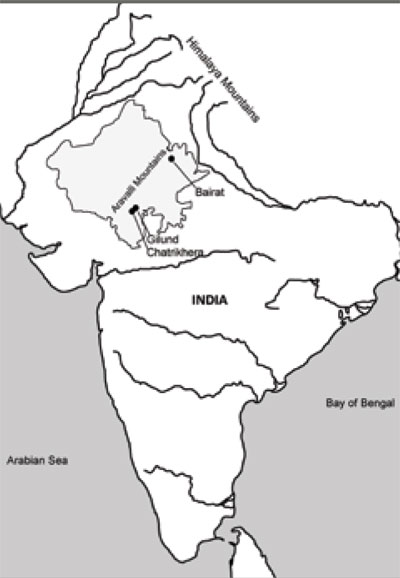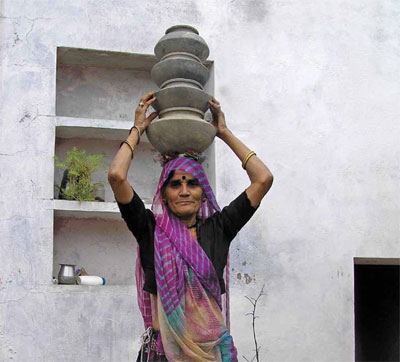
It was a sweltering day in June of 2009. We were walking in the sun, striving to finish our survey work in the cotton fields in the few days that remained before the monsoon arrived. The villagers had already plowed the fields several times, which brought fresh artifacts to the surface and helped our study. Soon, however, the farmers would start planting, and we wanted to wrap up our transect work so that we would not trample the young seedlings. We were working in the outskirts of Chatrikhera, a small village that has been occupied for thousands of years. By walking transects in the plow-zone, we sought to determine how far the ancient occupation extended into the fields beyond the boundaries of the modern village. As one of us photographed pot sherds that we had just discovered, the other took copious notes to describe our finds. Although it was unbearably hot, a large group of children—our daily companions—approached to show us their homemade wire toy cars and offered us tiny yellow fruits that they had retrieved by climbing high up a nearby tree. Disappointed that we were too busy to play with them, they eventually moved on. We were looking forward to finishing up in the fields, eager to begin our work in the village itself. Our research took us right into the heart of the small agricultural community of Chatrikhera, which had been built on top of an ancient habitation mound that was first occupied in the 3rd millennium BC.
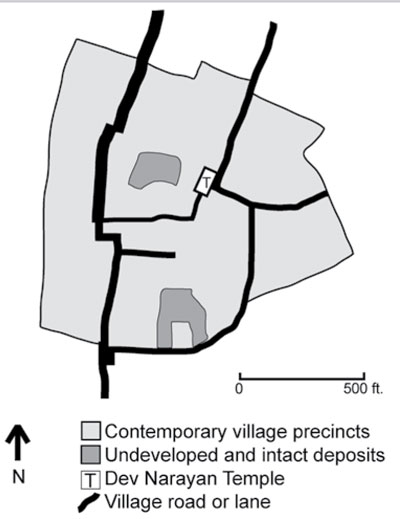
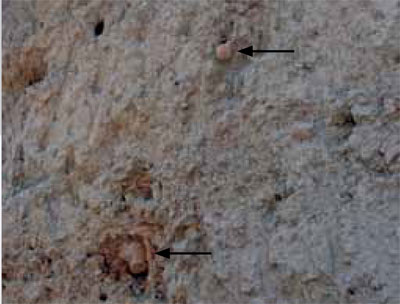
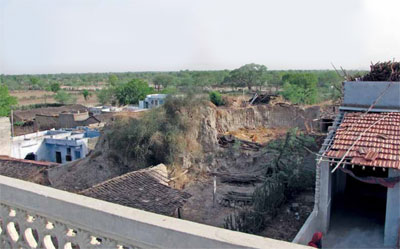
The village is small, with approximately 30 households, and only four narrow lanes (two run north-south and two run east-west). Although many houses were built on top of the mound generations ago, two undeveloped areas remain in the center of the village. Approximately 9 m high at the apex, these currently unoccupied deposits have been cut open in several places to accommodate expanding houses and courtyards. The result is a mound that has been transformed into a series of courtyard walls that are almost perfectly straight. These vertical profiles reveal stratigraphy and artifacts including house floors, hearths, whole pots, storage pits, and miscellaneous objects of everyday life spanning nearly 5,000 years. The mound grows smaller every year since the monsoon brings heavy erosion; after the rains, the residents clear the eroded mud and artifacts, remove unstable deposits, and make room for themselves in an ever-expanding village.
The Chatrikhera Archaeological Research Project, a joint project of the University of New Hampshire, City University of New York, the Institute of Rajasthan Studies, Rajasthan Vidyapeeth University (Udaipur, India), and Deccan College (Pune, India) documents the long-term history present at this site. In our first season (Summer 2009), we mapped the mound and village, conducted a field survey, and extensively photo-documented the mound and artifacts. In addition, because of the unique nature of the site, our first season focused on building trust with the local community. With this in mind, we concentrated on interviewing residents about the mound and village history, and creating relationships within the local community, so that we could establish agreements for continued work in the future, and understand how our research might impact or be perceived by residents. Before beginning our work we met with the village Sarpanch (elected official) and held a public meeting to explain our project. Many residents were familiar with the five-year long excavations that took place at Gilund, a contemporaneous archaeological site located 4 km away, and recognized our research goals. Some residents had visited those excavations and seen the exposed mudbrick buildings and artifacts firsthand.
Much of our season was spent interviewing residents to learn about the mound and people’s attitudes towards it. We conducted 21 formal interviews and dozens of informal discussions in both public and private settings. Interviews conducted on house verandahs or the main temple platform (a public gathering place) were simultaneously ad-hoc public forums where multiple people joined the discussion. These interviews were paired with sessions conducted within the privacy of people’s homes, which allowed participants to speak more freely and in an uninterrupted fashion. In addition, we circulated a detailed photo album of the small finds from Gilund in order to elicit comments from those who had seen these things in their own yards. The photos showed small terracotta bull figurines, stone tools, silver coins, iron bells, small clay lamps and boxes, copper knives, sling balls, shell spoons, and various ornaments like ear spools, beads, and bangles. Most villagers said that they had seen one or more of these items in the mound or in the piles of excavated backdirt on the edges of the village. However, few claimed to have saved the items. “They are afraid of going to jail,” explained one man who admitted that most residents were not interested in collecting these broken artifacts. We assured the residents that they were not breaking the law, although selling artifacts or collecting artifacts from specially designated “centrally protected” sites is illegal in India. However, it took time to build trust; some of our most important interviews occurred at the end of our season after people came to know us better, and to understand the nature of our research.
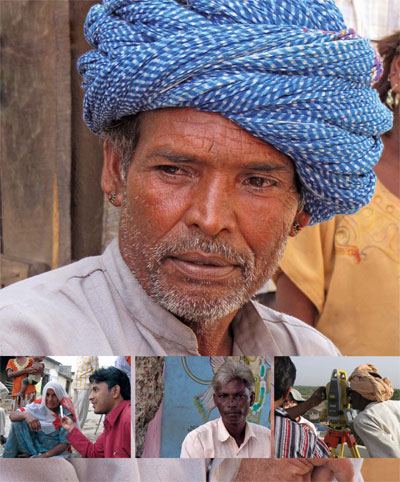
Many people reported seeing objects and artifacts in the mound, including pottery, bones, stone objects, iron bell fragments, and coins. Although most of the pottery is shattered, full pots were occasionally found. One woman led us into her yard where she showed us three large pots sitting upright in front of the remaining intact mound. She explained that they were such nice pots she was preserving them until she could find a use for them, keeping them near the place where they came out of the mound. Other residents also showed us whole pots that they had found and were now preserving.
One young woman took an intense interest in our project; she brought us into her family’s animal yard, which abuts the southern edge of the main mound. She showed us how the soil washes down from the top of the mound during the monsoon. Often, artifacts fall out of the mound, and the villagers take a practical approach to conserving them. Her family had saved a pot that they use as a planter for a flowering plant. “These are useful things,” she said, “so I saved them. Other things are consumed, finished, so I threw them away.” This practical approach is shared by many of the villagers who also keep or discard the artifacts they find based on their use-value. As most artifacts are broken, they are often scooped up and, with the eroded soil, dumped outside.
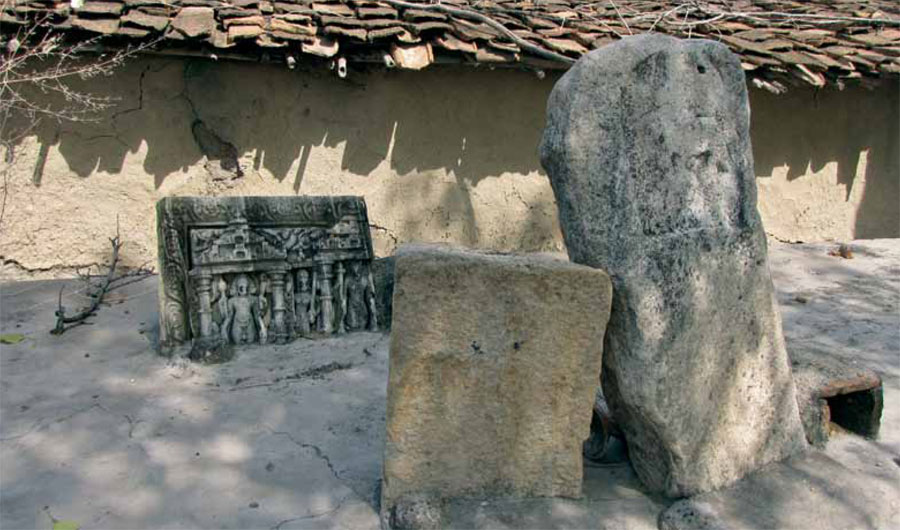
In addition to reused pots, we photo-documented the reuse of dozens of other items, most notably different forms of groundstone, including various querns, mortars, and pestles. While many women in Chatrikhera use querns in their daily cooking, they tend to use modern querns of different shapes and materials that are purchased outside of the village. However, throughout the village, various older querns and hand-held grinders are used as construction material where they serve as building stones or road pavers. Some older querns were used as water troughs for animals, while one held a fence post and was used as a door-pivot. Still others were cached in much the same way as the three intact pots and were being saved for some future use. The reuse of artifacts is a common practice in many parts of the world. Such reuse likely happened in ancient times as well, and results in mixed depositions. Most of these objects lack distinguishing marks that indicate in which time period they were manufactured and originally used. As a result, we focus on the most recent period of use of these artifacts.
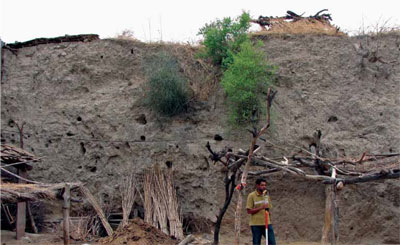
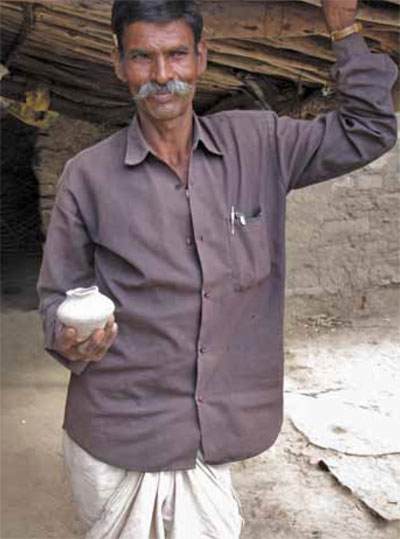
One of the women living on the mound told us, “It’s good that you care for these things.” She explained, “I also care for my own things” and showed us one pot that she found in the mound. “I have been caring for it for 15 years. . . when I found the pot it was broken on the top, so I put plaster on top of the pot.” She showed us the large chip in the rim and explained how she fixed it. She likes the pot and uses it to catch water that falls from a larger modern ceramic pot placed above it. After several weeks of meeting and talking with her and her husband, they granted us permission to return and excavate behind their house in coming years.
Many of the villagers told us that the mound is smaller today than when they were children. The population of Chatrikhera continues to increase, and this has put pressure on families to expand their households into all remaining available space in the village. As a result, the mound grows smaller every year. The villagers also told us stories of earthquakes, windstorms, mudslides, and heavy monsoon rains, all of which damaged the mound over the centuries. Digging has also occurred for centuries as the villagers seek out the ash, charcoal, and bone-rich soil to spread on their fields as fertilizer. In many ways, the story of Chatrikhera is not unusual; hundreds of thousands of ancient mounds around the world are located in villages that struggle to balance their respect for history with their desire to develop and become economically strong.
As many of the families of Chatrikhera have lived here for generations, all have stories to tell about the mound, the deep history of the village, and the artifacts that they have seen. The name Chatrikhera itself is intertwined with the oral and material history of the village. The name means “hill of the cenotaph,” which the villagers say refers to a stone marker located next to the temple on the highest point of the mound. The cenotaph is badly eroded but has a clear image of a horse and resembles many herostones that can be found throughout India that usually date to the Middle Period (see sidebar). What makes this stone unusual, though, is that the horseman is said to be headless. According to the residents, the stone was placed there in ancient times to mark a remarkable arrival in the village of a headless horseman. The story says that the man had been fighting in a battle when he was decapitated. Although headless, he continued to fight until he won the battle, and then he rode on his horse until he arrived in Chatrikhera and fell down. The ancient residents were so amazed by this event, that they buried the man and created a monument to honor him. The Village Sarpanch, Nanji Ram Bhil, says that all of this happened, “many years ago, a long time ago. This is how people remember the story. Adults tell the story, children tell the story, like this, people remember this story.”
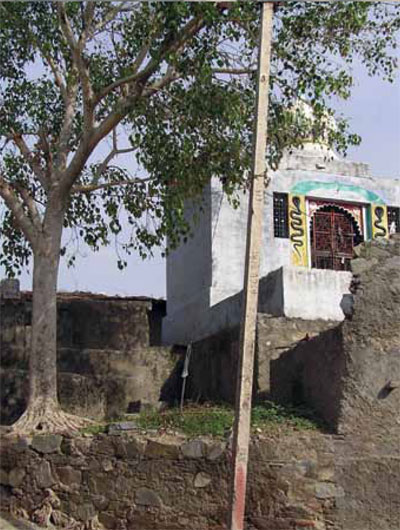
Our discussions with the residents of Chatrikhera helped us to understand how they think about the mound in their midst. They also helped to build trust and address their concerns about our work. As we move into the excavation phase of our project, we look forward to having many more conversations with the residents about the mound, archaeology, ancient objects, heritage, and history.
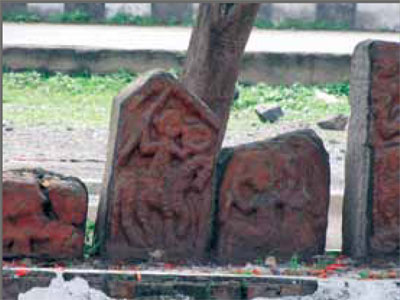
Herostones are small stone markers that memorialize men and women who have died in battle or while doing a heroic feat. Great regional and chronological variation can be found in the stones, but all contain a central image of the person being honored. One variation is the satistone or stones erected to honor women who threw themselves on their husband’s funeral pyre. Herostones are often preserved, sometimes within temple precincts, and today many people conduct pujas, or prayers, at the stones.
The herostone at Chatrikhera features the image of a horse; unfortunately, the upper portion of the stone, where the hero would be outlined, has been badly eroded (see far right, stone on right). Many herostones of southern Rajasthan feature figures called jhunjarji (respected struggler) or bhomiyaji (respected protector of the earth). Both of these kinds of heroes were decapitated in battle and continued to fight fiercely. After the battle, they began to travel towards home, when they met someone, usually a woman, who pointed to them and said, “Look, that man is riding a horse, but he doesn’t have a head.” Once the fatal wound has been pointed out to the hero, he instantly dies and falls to the ground. In her book, The Goddesses Henchmen: Gender in Indian Hero Worship, Lindsey Harlan explains that this story is common throughout Rajasthan, and that it exemplifies the idea that women interfere with and stop the male drive for war. According to legend, the hero is then buried, and the herostone is erected as a memorial to the amazing events.
Dasgupta, D. “A Study of Site Catchment Analysis of Gilund: A Chalcolithic Settlement in the Banas Basin, Rajasthan.” Man and Environment 31:2 (2006):70-74.
Harlan, Lindsey. “On Headless Heroes: Pabuji from the Inside Out.” In Multiple Histories: Culture and Society in the Study of Rajasthan, edited by Lawrence A. Babb, Varsha Joshi, and Michael W. Meister, pp.117-40. Jaipur: Rawat Publications, 2002.
—. The Goddesses Henchmen: Gender in Indian Hero Worship. New York: Oxford University Press, 2003.
Hooja, R. A History of Rajasthan. New Delhi: Rupa & Co., 2006.
—. The Ahar Culture and Beyond: Settlements and Frontiers of `Mesolithic’ and Early Agricultural Sites in Southeastern Rajasthan, c. 3rd–2nd Millennia B.C. Oxford: British Archaeological Reports International Series 412, 1988.
Indian Archaeology–A Review. 1962-63:19-20.
Khandwalla, K.P. “Preservation of India’s Archaeological Heritage through Archaeologists-Public Interaction: Issues and Strategies.” In Archaeology as History in Early South Asia, edited by H.P. Ray and C.M. Sinopoli, pp. 118-52. New Delhi: Indian Council of Historical Research, 2004.
Shinde, V., G. L. Possehl, and M. Ameri. “Excavations at Gilund 2001-2003: The Seal Impressions and Other Finds.” In South Asian Archaeology 2003, edited by U. Franke-Vogt and H.-J. Weisshaar, pp. 159-69. Aachen: Linden Soft, 2005.

